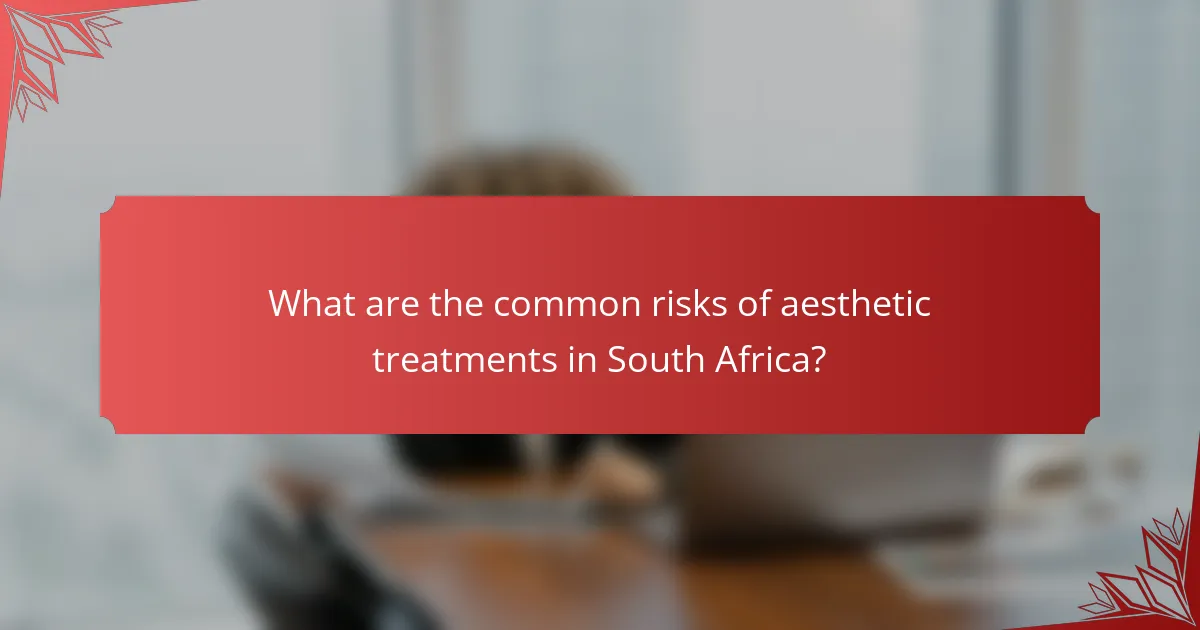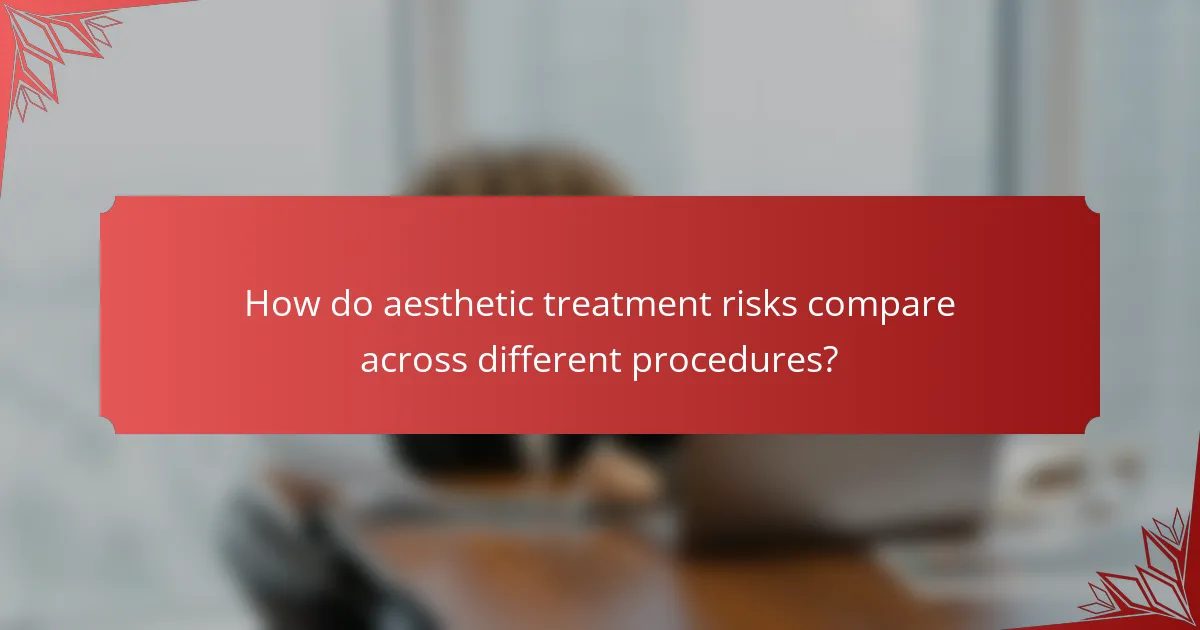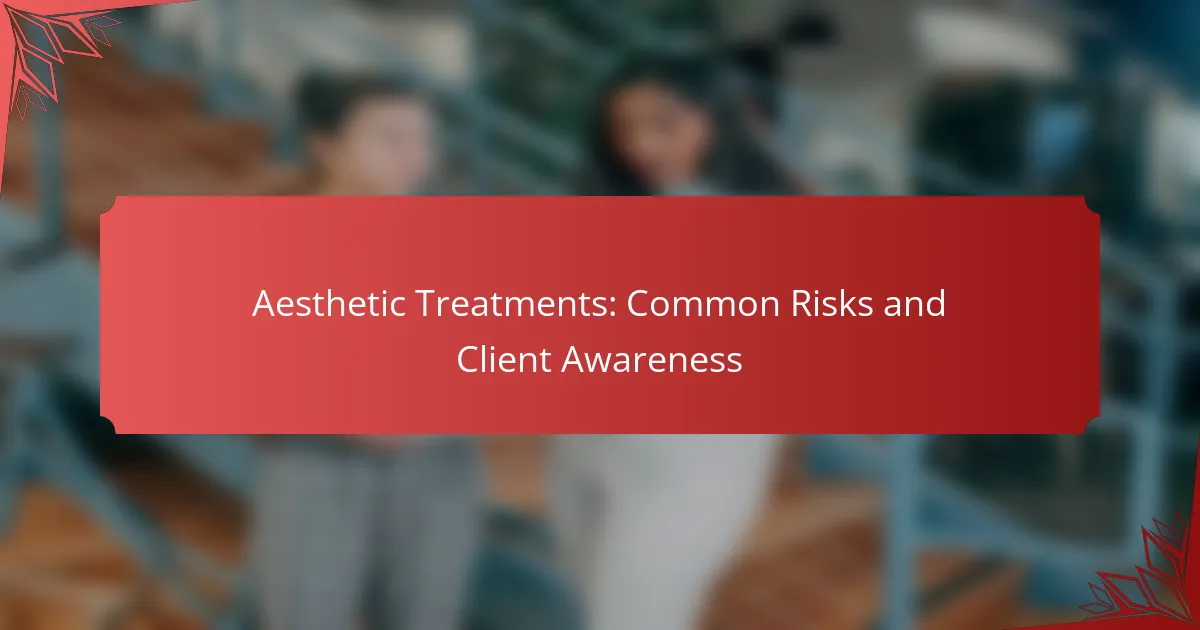Aesthetic treatments can offer transformative results, but they also come with common risks that clients must consider. Being aware of these risks is essential for making informed decisions and preparing for any potential complications. By choosing qualified practitioners and understanding the procedures, clients can enhance their safety and satisfaction with the outcomes.

What are the common risks of aesthetic treatments in South Africa?
Aesthetic treatments in South Africa carry several common risks that clients should be aware of before proceeding. Understanding these risks can help individuals make informed decisions and prepare adequately for potential complications.
Infection risks
Infection is a significant risk associated with aesthetic treatments, particularly those that involve injections or incisions. Bacteria can enter the body through broken skin, leading to localized infections or, in severe cases, systemic issues.
To minimize infection risks, ensure that the treatment is performed in a sterile environment by a qualified professional. Post-treatment care, including proper cleaning and avoiding touching the treated area, is crucial.
Allergic reactions
Allergic reactions can occur with various aesthetic treatments, especially those involving fillers or topical agents. Clients may experience redness, swelling, or more severe symptoms depending on their sensitivity to specific substances.
Before undergoing treatment, discuss any known allergies with your practitioner. A patch test may be recommended to identify potential reactions, helping to prevent adverse effects during the procedure.
Scarring potential
Scarring is a possible outcome of aesthetic treatments, particularly those that involve incisions or deeper skin penetration. The risk of scarring varies based on skin type, treatment technique, and aftercare.
To reduce the likelihood of scarring, follow your practitioner’s aftercare instructions carefully. Avoid sun exposure and keep the area moisturized to promote healing.
Unsatisfactory results
Unsatisfactory results are a common concern for clients undergoing aesthetic treatments. Expectations may not align with the outcome, leading to disappointment or the need for additional procedures to correct issues.
To manage expectations, have a thorough consultation with your practitioner, discussing desired outcomes and potential limitations. Consider viewing before-and-after photos of previous clients to gauge realistic results.
Emotional impact
The emotional impact of aesthetic treatments can be significant, as clients may experience anxiety or dissatisfaction with their appearance post-treatment. This can affect self-esteem and overall mental health.
It is essential to approach aesthetic treatments with realistic expectations and a clear understanding of the potential emotional effects. Seeking support from friends, family, or mental health professionals can be beneficial if feelings of dissatisfaction arise.

How can clients mitigate risks associated with aesthetic treatments?
Clients can mitigate risks associated with aesthetic treatments by carefully selecting qualified practitioners, conducting thorough research, understanding their treatment options, and discussing their medical history. These steps help ensure safety and satisfaction with the results.
Choosing qualified practitioners
Selecting a qualified practitioner is crucial for minimizing risks in aesthetic treatments. Look for licensed professionals with relevant certifications and experience in the specific procedure you are considering. Checking reviews and testimonials can also provide insight into their expertise and patient satisfaction.
In many countries, practitioners should be registered with a regulatory body. For instance, in the United States, the American Board of Medical Specialties provides a directory of certified professionals. Always verify credentials before proceeding.
Conducting thorough research
Researching the treatment and its potential risks is essential for informed decision-making. Clients should read up on the procedure, including its benefits, side effects, and recovery time. Reliable sources include medical journals, professional associations, and reputable clinics.
Consider joining online forums or support groups where past clients share their experiences. This can provide valuable insights and help set realistic expectations regarding outcomes and recovery.
Understanding treatment options
Clients should familiarize themselves with various treatment options available for their desired results. Each procedure comes with its own set of risks and benefits, so understanding these can help in making an informed choice. For example, fillers may offer immediate results but require maintenance, while surgical options may provide longer-lasting effects but involve longer recovery times.
Discussing different techniques with your practitioner can also reveal alternatives that may be safer or more suitable for your specific needs. Don’t hesitate to ask questions about the pros and cons of each option.
Discussing medical history
A comprehensive discussion of your medical history with the practitioner is vital for identifying potential risks. Inform them about any pre-existing conditions, allergies, or medications you are taking, as these factors can influence treatment outcomes.
Practitioners may require certain medical clearances before proceeding with treatments, especially for invasive procedures. Being transparent about your health can help ensure a safer experience and better results.

What should clients know before undergoing aesthetic treatments?
Clients should be well-informed about the aesthetic treatments they are considering, including the procedures, potential risks, and aftercare. Understanding these aspects can help ensure a safer experience and more satisfactory results.
Pre-treatment consultations
Pre-treatment consultations are essential for discussing your goals, medical history, and any concerns with the practitioner. This meeting allows the professional to assess your suitability for the treatment and provide personalized recommendations.
During the consultation, ask about the techniques used, expected outcomes, and any alternatives. Ensure that the practitioner is licensed and experienced in the specific treatment you are considering.
Post-treatment care
Post-treatment care is crucial for optimal recovery and results. Follow the specific aftercare instructions provided by your practitioner, which may include avoiding certain activities, applying topical treatments, or attending follow-up appointments.
Common post-care recommendations include keeping the treated area clean, avoiding sun exposure, and using gentle skincare products. Adhering to these guidelines can help minimize complications and enhance the effectiveness of the treatment.
Realistic expectations
Having realistic expectations is vital when undergoing aesthetic treatments. Understand that results can vary based on individual factors such as skin type, age, and the specific procedure performed.
Discuss your desired outcomes with your practitioner to gain a clear understanding of what is achievable. Remember that some treatments may require multiple sessions for optimal results, and patience is often necessary.
Potential side effects
Potential side effects can occur with any aesthetic treatment, ranging from mild to more serious issues. Common side effects include redness, swelling, bruising, or temporary discomfort in the treated area.
Serious complications are rare but can include allergic reactions or infections. It’s important to discuss these risks with your practitioner and know how to recognize any adverse reactions that may require medical attention.

What are the legal regulations for aesthetic treatments in South Africa?
In South Africa, aesthetic treatments are regulated to ensure safety and efficacy. Practitioners must comply with specific laws regarding qualifications, facility licensing, and informed consent to protect clients and maintain industry standards.
Practitioner qualifications
Aesthetic practitioners in South Africa must be registered with the Health Professions Council of South Africa (HPCSA) or relevant professional bodies. They typically need to hold a medical or nursing qualification, along with specialized training in aesthetic procedures.
It is advisable for clients to verify the credentials of their practitioners, ensuring they have the necessary qualifications and experience in the specific treatments being offered.
Facility licensing requirements
Facilities providing aesthetic treatments must be licensed and comply with health and safety regulations set by local authorities. This includes maintaining hygiene standards and ensuring that the environment is safe for clients.
Clients should check if the facility is registered and has the appropriate licenses, which can often be verified through local health departments or regulatory bodies.
Informed consent laws
Informed consent is a legal requirement in South Africa for aesthetic treatments. Practitioners must provide clients with comprehensive information about the procedures, risks, and expected outcomes before obtaining consent.
Clients should ensure they fully understand the information provided and feel comfortable asking questions before proceeding with any treatment. This helps in making informed decisions and enhances overall safety.

How do aesthetic treatment risks compare across different procedures?
Aesthetic treatment risks vary significantly depending on the procedure. Understanding these differences helps clients make informed decisions about their options and potential complications.
Botox vs. dermal fillers
Botox and dermal fillers both aim to enhance facial appearance but carry distinct risks. Botox, a neurotoxin, can lead to temporary muscle weakness, drooping eyelids, or allergic reactions. In contrast, dermal fillers, which add volume, may cause swelling, bruising, or lumps if not administered correctly.
Clients should consult with qualified professionals to discuss their medical history and any potential allergies. It’s essential to choose reputable clinics that follow safety regulations to minimize risks.
Laser treatments vs. chemical peels
Laser treatments and chemical peels are popular for skin rejuvenation but have different risk profiles. Laser treatments can cause skin irritation, discoloration, or scarring, especially in individuals with darker skin tones. Chemical peels, on the other hand, may lead to redness, peeling, and sensitivity, particularly for deeper peels.
Before undergoing either treatment, clients should assess their skin type and discuss potential side effects with their practitioner. Proper aftercare is crucial to reduce complications and achieve optimal results.
Facelift vs. non-surgical options
Facelifts are surgical procedures that provide significant results but come with higher risks, including infection, scarring, and anesthesia complications. Non-surgical options, such as thread lifts or ultrasound treatments, typically have fewer risks but may offer less dramatic results.
Clients should weigh the benefits and risks of each option, considering factors like recovery time and desired outcomes. Consulting with a board-certified plastic surgeon or dermatologist can help determine the most suitable approach based on individual goals and health status.
